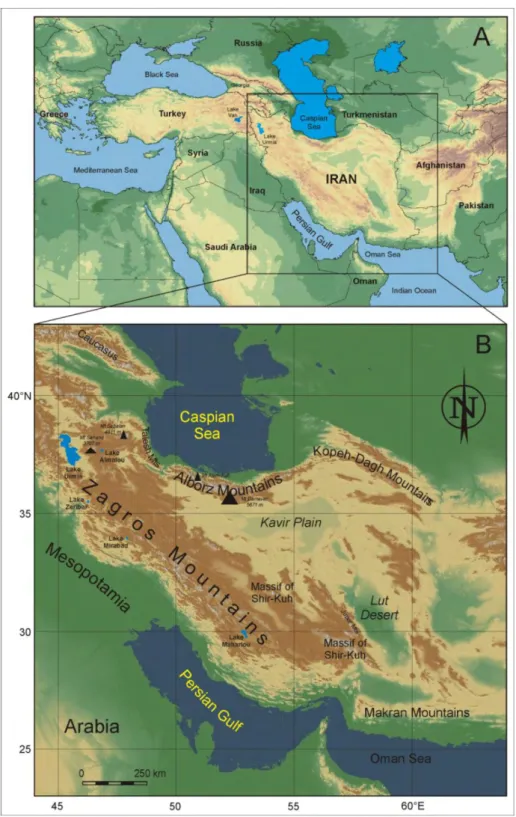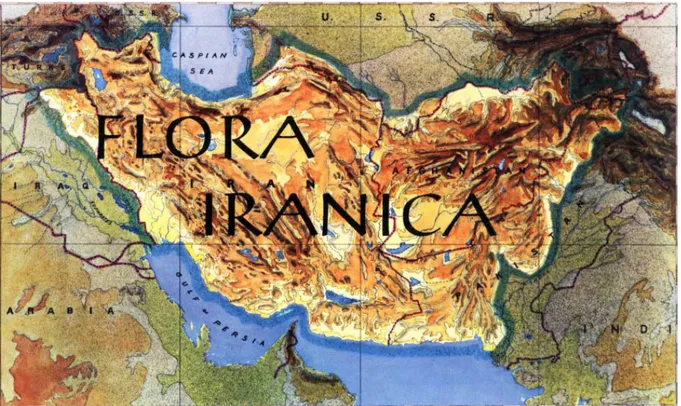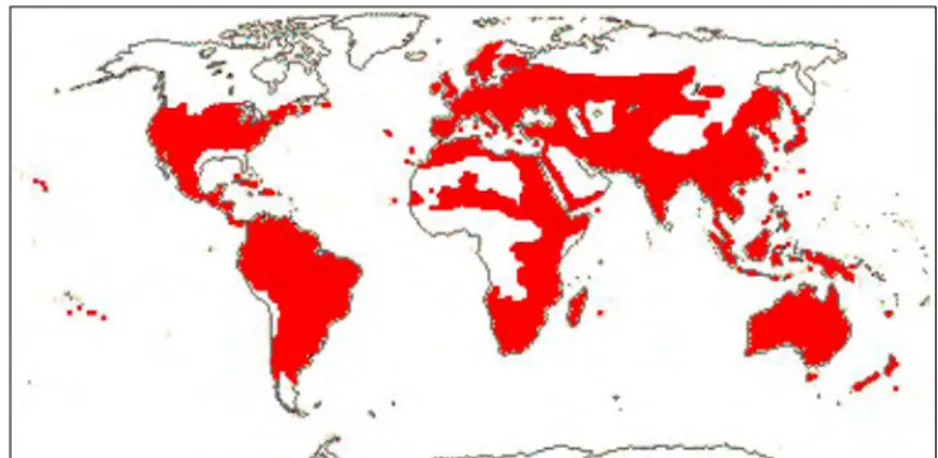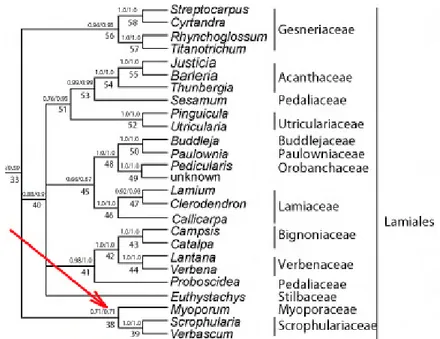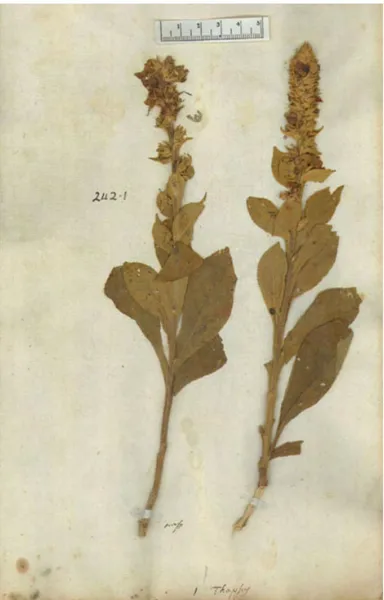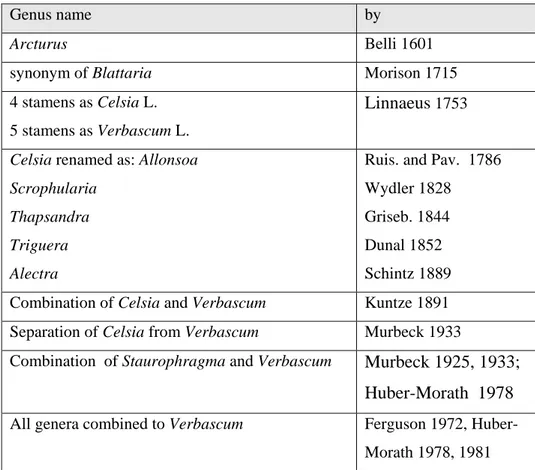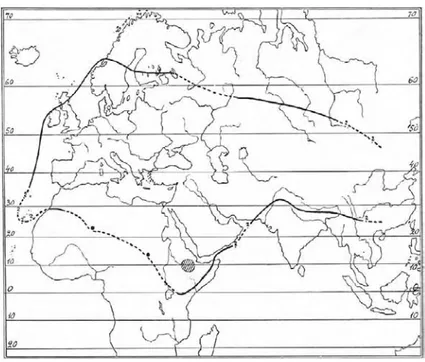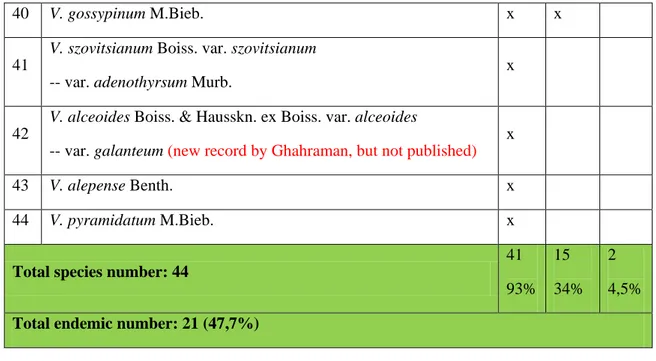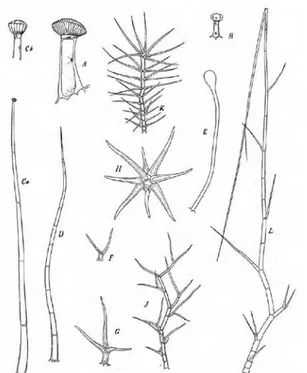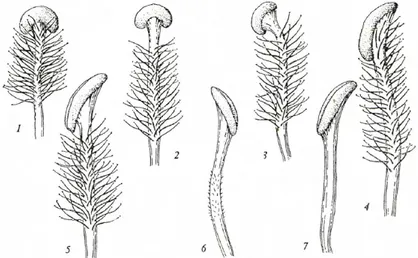Acknowledgements
I would like to express my deepest gratitude to the following people who without their help and support, this thesis would never have been achieved. For four wonderful years, I learned not only science but I also gained life experience and unforgettable friends.
First of all, I would like to convey my sincere gratitude to my supervisors Dr. Laure Civeyrel for all her helps and supports during these years. I am speechless toward her helps since accepting me in her group, taking extra care to ensure me the best conditions possible for the continuation of my thesis, and her regular work discussion and speed in revising my articles and chapters.
Also I would like to present my special gratitude to my co-supervisors Prof. Farideh Attar for all help and guides, I never forget her hospitaly and unforgettable moments during our field trips in Iran.
There is a famous saying which goes “The great boss makes people believe in themselves and feel special, selected, anointed” and this is definitely who you are. You are true scientist with your door always open for discussion and advices.
They always followed up my progress, my daily troubleshooting and experiments. I learned a lot from them rich scientific background in botany and phylogeny.
One more thanks goes to my dear colleague Céline PELISSIER who was always helping me in laboratory works. She was always there to give me hand in the lab works.
A special thanks goes to my dear friend and colleague Dr. Maxime FERVAL for his advices and discussion during my laboratory works which enriched my skills.
I am thankful for all my friends, colleagues and administrative team at the EcoLab for the pleasant moments that we spent together.
A special thanks to Prof. Ahmad SARRAFI for all his supports and advices before and since the day I arrived in France.
A special thanks to Prof. Ali PEIGHAMBARI who initiated the think of coming to France and for his endless supports and guides before and since the day I arrived in France.
Special Thanks to the Kiai, Riahi and Movahhed familly, who offered me great helps since the day I arrived in France.
I am grateful to my parents, my sister, my brother and my familly who believed in me and supported me all my life to reach this moment, I am so lucky to have such parents and family. One special thanks to my wife and daughter who accepted and believed my situation during these years.
Table of contents
Abstract
……….……….………..……… 1Résumé
……….………….……..…………...… 3Introduction
(In French)
……….……….…..…………... 5Chapter I - Introduction
1. 1. General introduction ……….………..….…... 91. 2. Flora Iranica ………...……..…..…. 14
1. 3. Climatic and Floristic Regions of Iran ………….…....…….…………...…. 14
1. 3. 1. Irano-Turanian floristic region ………..………..…..…. 15
a) The Irano-Turanian plain area zone ……….………. 16
b) The Irano-Turanian mountain zone ………..….……... 17
1. 3. 2. The Hyrcanian floristic region ………...…. 17
1. 3. 3. Sudanian ……….……..…... 18 1. 3. 4. Saharo-Arabian ………...…. 18
Chapter II - Verbascum
2.1. Introduction ………...…. 23 2.2. Classification of Scrophulariaceae ………...… 23 2.3. Age of Scrophulariaceae ………..………... 242.4. The genus Verbascum L. .……….………..………… 24
2.5. Type of genus .……….………..……....……. 25
2.6. Ecology, Habitat and Distribution .……….……...………..…. 27
2.7. Endemicity of Verbascum in Iran .……….……...………. 29
2.8. Economical features of Verbascum.……….…....………. 32
2.9. Morphology of Verbascum .……….………...………. 32
2.10. Chromosome counts .……….………...…. 36
2.11. Characters used for intra and infra-generic classification …………... 36
2.12. Diagnostic characters ………. 37
Chapter III - Verbascum articles
3.1. Introduction ………...……….…... 41
3.2. Article 1: Verbascum oreophilum var. oreophilum and Verbascum cheiranthifolium var. asperulum (Scrophulariaceae) two new records for the flora of Iran ……….…….………….. 42
3.3. Article 2: Verbascum shahsavarensis (Scrophulariaceae), a new species for Flora of Iran ……….… 49
3.4. Article 3 (Submitted): Verbascum parsana (Scrophulariaceae), a new species for Flora of Iran, based on Morphological and Molecular Evidence ………….…….…. 55
3.5. Article 4 (preparation): Molecular Phylogeny of Iranian Verbascum (Scrophulariaceae) using Nuclear and Chloroplastic regions ….………..…. 66
Chapter IV - Artemisia
4.1. Introduction ... 974.2. The genus Artemisia L. ... 98
4.3. Origin and Diversification Centre ... 98
4.4. Taxonomy ... 99
4.5. Artemisia in Iran ... 101
4.6. Chromosome number and Polyploidy ... 104
4.7. Morphology ... 104
4.8. Previous phylogenetic relationship studies ... 105
4.9. The main goals of the present study ... 106
Chapter V - Artemisia Article
5.1. Article: Molecular Phylogeny of Turkish and Iranian Artemisia (Asteraceae) With ITS and ETS ………..…………...… 111Conclusion and Perspective
……….……….…Appendices
Appendix I: Verbascum determination key of Flora Iranica ……….…… 157
Appendix II: List of Verbascum specimen for Iran and their sysnonyms, grouped by Huber-Morath based on flowers on axil and hairs (Taxon name, Synonym and general distribution) ……….………….. 162
Appendix III: Distribution Maps of genus Verbascum in Iran ………...…….. 168
Appendix IV: Artemisia sections by De Candolle (1837) ………..…. 176
1
Abstract
The purpose of this doctoral thesis was to investigate the biogeography and evolution of two groups of plants in Iran: Verbascum and Artemisia. To fulfill this objective, molecular phylogenies were built for these two genera and morphological characters were analyzed. Samples were collected in Iran during field trips and compared to herbarium specimens from several herbaria in Europe and Iran. During this survey nearly all species from Iran were collected. For molecular studies they were collected in silica-gel, from which DNA was extracted and sequenced for several regions.
For Verbascum we constructed a phylogeny with 77 taxa representing 38 species and
sequenced them with Nuclear (ITS) and four chloroplastic regions (trnL-F, trnS-G, trnH-psbA and partial matK). Morphological characters used to delimits taxonomic groups in this large genus were closely examined and compared to the molecular phylogeny.
We built another phylogeny for Artemisia with only nuclear regions ITS and ETS due to the lack of resolution of chloroplastic markers for this genus. We were able to include 48 taxa in our analysis, 22 from Iran and we added 26 from Turkey. As many studies have already been conducted on Artemisia, we also included them into a large phylogeny, with almost all the previous published sequences of Artemisia to establish a robust phylogenetic framework.
The results from Verbascum’s molecular phylogeny showed this is a monophyletic genus, but it cannot confirm the previous sub-genera classification provided by Murbeck (1933) and Huber-Morath (1981). Our result showed that some of the key characters proposed by those authors are plesiomorphic and probably only a combination of character states can help to do some grouping. During the survey of Verbascum species, some new records for Iran and two news species were encountered: V. shahsavarensis and V. parsana.
The inclusion of Iranian and Turkish species of Artemisia widened the existing studies particularly poor in species from both regions. The phylogenetic results of Artemisia showed that partial ETS could provide more variable and potentially informative sites than the whole ITS. However the addition of Iranian and Turkish taxa did not produce topology conflicts among the major Artemisia lineages and results largely agreed with previous studies with a few exceptions. Also, our results confirm the decision to sink some species like
2
Sphaeromeria capitata (A. capitata) and Sphaeromeria argentea (A. macarthuri) into the genus Artemisia.
This work brought new data to a poorly known genus, Verbascum in that region and added
species not included previously in phylogenies for Artemisia. Overal this study showed that
morphological characters alone are not enough to define subgeneric classification. The result
of Verbascum pave the way for future investigations, and Artemisia analysis clearly states that
some subgenus or sections of Artemisia, require changes in their delimitation.
Keywords: Artemisia, chloroplactic genes, classification, ETS, evolution, Iran, ITS, phylogeny, systematics, Turkey, Verbascum.
3
Résumé
L'objectif de cette thèse était d'étudier la biogéographie et l'évolution de deux groupes de plantes en Iran: Verbascum et Artemisia. Pour réaliser cet objectif, plusieurs phylogénies moléculaires ont été construits pour chacun de ces deux genres, et plusieurs caractères
morphologiques ont été analysés. Les échantillons pour cette thèse ont été collectés en Iran au cours de mission de terrain et comparés aux spécimens d'herbier de plusieurs herbiers en Europe et en Iran. Cette étude a permis la collecte de presque toutes les espèces d’Iran. Pour les études moléculaires des feuilles ont été prélevées et conservées dans du silica-gel, à partir duquel l'ADN a été extrait et séquencé pour plusieurs régions.
Pour Verbascum nous avons construit une phylogénie moléculaire comprenant 77 taxons représentant 38 espèces, à l’aide de la région nucléaire (ITS) et de quatre régions
chloroplastiques (trnL-F, trnS-G, trnH-psbA et matK en partie). Les caractères
morphologiques utilisés pour délimiter les groupes taxonomiques dans ce grand genre ont été examinées attentivement et comparées à la phylogénie moléculaire.
Nous avons construit une autre phylogénie pour Artemisia avec seulement deux régions nucléaires ITS et ETS, en raison de l'insuffisance de résolution des marqueurs
chloroplastiques pour ce genre. Nous avons pu inclure 48 taxa dans notre analyse, 22 en provenance d’Iran et 26 en provenance de Turquie. Comme de nombreuses études ont déjà été menées sur Artemisia, nous avons inclus nos séquences dans une grande phylogénie, incluant presque toutes les séquences publiées lors d’études précédentes en vue de construire un cadre phylogénétique robuste pour notre étude et de juger de l’apport des espèces turques et
iraniennes à la phylogénie d’Artemisia.
Les résultats de la phylogénie moléculaire de Verbascum montrent qu’il s’agit d’un genre monophylétique, mais n’a pas permis de proposer de classification infra-générique en accord avec la classification de Murbeck (1933) ou d’Huber-Morath (1981). Certains des caractères clés proposées par ces auteurs sont plésiomorphes et seule une combinaison de caractères peut aider à faire quelques regroupement. Au cours de cette étude deux espèces nouvelles ont été décrites: V. shahsavarensis et V. parsana et des espèces sont notées pour la première fois en Iran.
4
L'inclusion des espèces iranienness et turques d'Artemisia a permis d’élargir les études existantes particulièrement pauvres en espèces provenant de ces deux régions. Les résultats phylogénétiques pour Artemisia ont montré que la région ETS fournit plus de sites variables et potentiellement informatifs qu’ITS. Cependant l'ajout de taxons iraniens et turcs n'a pas résolu les problèmes de délimitation des lignées majeures d'Artemisia et les résultats largement congruents avec les études précédentes. En outre, nos résultats confirment la décision d’inclure dans Artemisia certaines espèces comme Sphaeromeria capitata (A. capitata) et Sphaeromeria argentea (A. macarthuri) dans le genre Artemisia.
En conclusion ce travail apporte des données nouvelles pour un genre peu étudié comme Verbascum et pour Artemisia des données sur des espèces non incluses précédemment dans les phylogénies d’Artemisia. Globalement cette étude a aussi démontré que les caractères morphologiques ne suffisent pas à définir de classification sub-générique dans ces deux genres et indiquent clairement que certains sous-genres ou des sections d'Artemisia comme Verbascum , exigent des changements dans leur délimitation.
Mots-clés: Artemisia, genre chloroplastic, classification, ETS, l'évolution, l'Iran, ITS,
5
Introduction
Cette thèse de doctorat a pour objectif d’étudier l'évolution de deux groupes de plantes en Iran. Deux phylogénie ont été construites, l'une pour le genre Verbascum et une autre pour le genre Artemisia. Ce manuscrit est divisé en cinq chapitres, chacun des chapitres présenté comme un article (publiés ou en préparation) encadrés par une introduction et une conclusion. Avec 1.640.000 kilomètres carrés l'Iran est situé dans la zone steppique de l'Asie centrale et possède une combinaison particulière d'écosystèmes très diversifiés, qui est à l’origine d’une des biodiversités floristique les plus riches de la région. Cette richesse spécifique s’explique par la diversité des conditions climatiques et topologiques, la présence de hautes montagnes au nord et de déserts du sud. Les principales chaînes de montagnes sont Alborz, Zagros, Kopetdague, Khorassan et Makran . Les plaines se trouvent le long de la mer Caspienne, du golfe Persique et du golfe d'Oman. En raison de cette hétérogénéité biogéographique, l'Iran possède plusieurs régions phytogéographiques particulières qui sont le résultat d'interactions complexes entre les différentes zones climatiques et floristiques adjacentes dans un contexte orographique spécial. Les activités anthropiques très anciennes ont également joué un rôle dans la physionomie diversifiée de ces régions. Ces études phylogénétiques s’inscrivent aussi dans une situation complexe de connaissance et de protection des écosystèmes iraniens.
Le genre Verbascum L. appartient à la famille des Scrophulariaceae stricto sensu, et à la tribu
des Verbasceae. Il en est l’un des genres majeurs (Judd 1999, Olmstead 2001, Fischer 2004, Oxelman 2005) et comprend environ 360 espèces dans le monde (Heywood 1993, Mabberley, 2008) dont 44 espèces en Iran (Huber-Morath 1981, Sharifnia 2011, Sotoodeh et al. 2014 et 2015). Outre les espèces, de nombreux hybrides ont été décrits, quand deux ou plusieurs espèces poussent ensemble. Ils forment des intermédiaires entre leurs parents dans la plupart des caractéristiques morphologiques (Ferguson 1972, Huber-Morath 1978, 1981, Murbeck 1933). Nos études phylogénétiques ont été réalisées avec des marqueurs moléculaires
chloroplastiques trnS-G, trnL-F et matK et nucléaire: ITS. Des taxa appartenant au genre ont été décrits avant l'époque de Linné (Karaveliogullari 2008): et nommés par Belli en 1601 : Arcturus. En 1753, Linné a nommé Celsia L. les plantes avec 4 étamines et Verbascum L. les spécimens avec 5 étamines.
Les espèces de Verbascum sont adaptées à différentes conditions écologiques, tels que les habitats xériques, semi-ouverts ou steppiques.
6
Basé sur Murbeck (1933), Heywood (1993), Judd (1999) et Mabberley 2008, Verbascum est largement distribué en Europe, en Asie et en Afrique avec trois zones de richesse spécifique importante, la zone irano-turanienne, l’Europe centrale et le Maghreb. 228 espèces sont présentes en Anatolie (Huber-Morath 1978), cette région étant le principal centre de
diversification. En Iran, environ 48% des espèces Verbascum iraniens sont distribués dans les provinces du Nord-Ouest, dans le voisinage de l'Anatolie turque (Sharifnia 2007). Ils peuvent être trouvés dans différentes parties de l'Iran à l'exception de la région Nubo-Sindian, dans le sud de l'Iran. Parmi les 44 espèces Verbascum distribués en Iran, 21 sont endémiques
(47,7%). La plupart des espèces endémiques (93%) appartiennent à la zone irano-turanienne, tandis que 15 (34%) appartiennent à la région Hyrcanienne et 2 (4,5%) appartiennent à la région soudanienne (Huber-Morath 1981, Sharifnia 2011, Sotoodeh et al. 2015).
Au cours de cette thèse quatre articles ont été rédigés sur le genre Verbascum, deux sont publiés, un est soumis et le dernier est en cours de correction. C’est le travail sur les spécimens collectés ou en herbiers, qui a permis ces publications.
Les Asteraceae (la famille du tournesol) ont une distribution mondiale, étant absent seulement du continent Antarctique et faiblement représentées dans les écosystèmes forestiers tropicaux. La famille se compose principalement d'herbes, d'arbustes, d'arbres ou de lianes (Simpson, 2006). C’est probablement la plus grande famille d’Angiospermes (Judd et al. 2008, Stevens 2011), avec plus de 1 590 genres et 23 600 espèces (Heywood 1985 Mabberley 2008). Cette grande famille a été divisée en plusieurs sous-familles. Les études phylogénétiques
moléculaires permis d’etablir une nouvelle classification de la famille.
Le genre Artemisia L. est le plus grand de la tribu des Anthemideae, comme de la famille des
Asteraceae. Il comprend plus de 500 taxons à divers niveaux spécifiques ou sub-spécifiques (le nombre varie selon les auteurs: McArthur 1979, 1998, 2001 Oberprieler, Vallès et
McArthur 2001, Martin et al 2003, Vallès et Garnatje 2005). Il est présent généralement dans les zones tempérées de l'hémisphère Nord, principalement dans les milieux arides et semi-arides, et possède seulement quelques représentants dans l'hémisphère Sud. Les espèces d'Artemisia sont pour la plupart des herbes vivaces, elles sont rarement annuelles ou
bisannuelles (Valles et al. 2003, Hayat et al. 2010, Garcia et al., 2011b, Pellicer et al., 2011a). C’est généralement la plante dominante de certaines communautés végétales telles que la steppe, la steppe subalpine, la steppe arbustive, semi-désertique et désertique (Vallès et
7
McArthur 2001). Leurs pollens sont reconnus comme indicateur du climat steppique (Erdtman 1952).
Le centre le plus important d'origine et de diversification des Artemisia est l'Asie centrale, l'Europe, le nord de l'Amérique et l'Afrique du Sud (Heywood 1985), et basé sur Ling (1982) et Valles et McArthur (2001), la région méditerranéenne et l’Amérique du Nord-Ouest sont deux centres de spéciation secondaires. La région méditerranéenne est un centre important de diversification pour Artemisia et surtout l'Iran et la Turquie. La plupart de cette richesse floristique se trouve dans la région irano-touranienne, situé à un croisment de plusieurs régions biogéographiques (Zohary 1973, Davis 1965-1985).
Le genre est taxonomiquement extrêmement difficile. Ces espèces présentent un grand éventail de formes, et de caractéristiques morphologiques, avec un certain polymorphisme (Gharhreman 2007, Pellicer et al. 2014, Haghighi et al. 2014a et 2014b).
De nombreuses tentatives ont été faites pour établir un classement infra-générique de ce grand genre depuis De Candolle (1837). La classification la plus récente, qui est plus ou moins largement acceptée, est principalement basée sur le type de capitules et des fleurons fertiles avec cinq grands groupes traités au rang de sous-genre (Absinthium, Artemisia, Dracunculus, Seriphidium, Tridentatae) (Torrel 1999, Valles 2001, Pellicer et al 2011a), auquel nous avons ajouté le sous-genre nouvellement défini : Pacifica.
Pour comprendre l'histoire évolutive de ce genre dans la région irano-touranienne, nous avons échantillonné tous les taxons de Turquie (26 taxa) et d'Iran (24 taxa), ainsi que quelques espèces non publiées d'Europe. Nous avons utilisé ITS, ETS pour la phylogénie. Nous les avons inclus dans une grande phylogénie avec la plupart des séquences publiées de GenBank pour ces régions.
Les espèces iraniennes et turques d'Artemisia appartient à trois sous-genres: Artemisia (y compris Absinthium), Dracunculus et Seriphidium, mais la majorité d'entre elles font partie des sous-genres Artemisia et Seriphidium. Aucun de ces sous-genres n’est monophylétique, à l'exception possible des sous-genres Tridentatae et de Pacifica.
9
Chapter I
11
Chapter I: Introduction
1. 1. General introduction
This doctoral thesis was done to investigate the evolution of two groups of plants in Iran. Two phylogenies were built, one for the genus Verbascum and another for the genus Artemisia. Samples were collected in Iran, and included in a large phylogeny to provide a robust framework for phylogenetical analyses in these genera, which encompasses nearly all their species in Iran.
This manuscript is divided into five chapters, each chapter as a paper (either published or in preparation) with an introduction and a conclusion.
Iran -with 1,640,000 square kilometers - is situated within the dry belt of Asia and displays a combination of different ecosystem and a rich biodiversity due to various climatic conditions and topology, from high mountains on the north to deserts in the south (Fig. 1.1). The
lowlands territories are found along the Caspian Sea, the Persian Gulf and the Gulf of Oman. High mountains occurs in half of the country, and the main mountain chains are Alborz, Zagros, Kopet Dagh, Khorassan and Makran (Fig. 1.2) (Ghahreman & Attar, 2000). Due to this heterogeneity, the biogeography of Iran is complex with several different
phytogeographic regions and is the result of complex interactions between different climatic zones and floristic influences in a special orographic context (Zohary 1973).
Anthropic activities have also played a role in shaping the physiognomy of those regions. Knowledge of the current situation of vegetation is vital for Iran because protection of ecosystems is a critical need, and our studies are a part of that framework. (Ghahreman & Attar, 2000).
12 Fi g 1.1 : L ay er in g o f v eg et at io n acco rd ing to t he d iffe re n t a lti tu d es o f A lb o rz mo u n ta in . ( fr o m N or ooz i 2010)
13
Fig 1.2: Geographical location of Iran in the Middle East with major geomorphological features. (From Djamali 2008 )
14
1. 2. Flora Iranica
The main published floristic work for this region is Flora Iranica (Rechinger 1963 – 2005; 176 fascicles published). The geographic area of this flora encompass the entire political boundaries of Iran, Afghanistan, N. Iraq, mountains of Turkmenistan, small parts of Azerbaijan (Talesh) and the western Pakistan up to the Sind river (Fig. 1.3).
Fig 1.3: The geographic area covered in Flora Iranica
The total number of species is 9977 with 1471 genera; 3318 species are given as endemic to this area (33%), out of which 1490 (Akhani 2006) species are endemic to Iran (24%). Based on Rechinger (1963-2010), Ghahreman & Attar (2000) and Akhani (2006), total number of Iranian taxa after addition of about 500 new species or records by Ghahreman & Attar (2000) and Akhani (2006) are about 7300 species, 167 families of vascular plants and 1215 genera. About 1,810 taxa are endemic (Ghahreman & Attar 2000).
1. 3. Climatic and Floristic Regions of Iran
The flora and vegetation of Iran have been extensively investigated since a long time (e.g. Rechinger 1963-2010; Zohary 1973; Léonard 1981-1989, 1991/1992; Klein 1994; Frey and Probst 1986; Frey et al. 1999), but the relationships between climatic parameters and plant distribution over the country have been poorly studied.
15
The bioclimatic analyses of Iran are based on application of simple bioclimatic indices such as the aridity index of de Martonne (Khodayari 1970), bioclimatic classification methods of Köppen (Adle 1960) and Emberger (Sabeti 1969).
The Emberger’s bioclimatic classification system (climography) seems to provide more concrete correlations between vegetation and bioclimatic zones of Iran (Sabeti 1969; Klein 1994). Djamali (2011) in his study applied the recent developed Global Bioclimatic
Classification System (Rivas-Martínez et al. 1997, 1999) to meteorological data of Iran. This system has been successfully applied to different parts of the world and seems to provide good matches between biome and climate boundaries (Rivas- Martínez et al. 1997, 1999; Amigo and Ramírez 1998; del Río González 2005).
Floristic regions are defined as geographical areas with distinct plant life or floras and they are characterized by endemic taxa at the level of species or higher (Takhtajan 1986,
McLaughlin 1994, Manafzadeh 2014). Zohary (1973) distinguishes four phytogeographical regions in Iran: 1) Irano-Turanian, in most of the central Iranian plateau and its bordering highlands, 2) Hyrcanian (Sub-region of Euro-Siberian), in the south of Caspian region, 3) Sudanian, in southern Iran, and finally 4) Saharo-Arabian in southwestern of Iran (Fig. 1.4). Takhtajan (1986), Léonard (1989), White and Léonard (1991) proposed some minor changes in Zohary’s classification but its concept was largely accepted. We will review them briefly below.
1. 3. 1. Irano-Turanian floristic region
The term Irano-Turanian floristic region (I-T region) was first defined by Edmond Boissier in Flora Orientalis (1867) and has subsequently been explained and delimited in different ways by various authors (Zohary 1973; Takhtajan 1986; Léonard 1989; Davis et al. 1994). The Irano-Turanian region covers a vast area of Iran from the southern slopes of Alburz mountains to highlands Lar-Makran mountain in the south.
The I-T region in Southwest Asia is one of the richest floristic areas of the Holarctic Kingdom (Fig. 1.4), with most of its species diversity found in the Iranian plateau, Anatolian plateau, and Central Asia (Zohary 1973; Takhtajan 1986; Léonard 1989; Davis et al. 1994; Manafzadeh 2014). This region is well characterized climatically, floristically and vegetationally and differ from the surrounding regions by its continental climate, manifested by the extreme ranges in temperature, both diurnal and annual, low precipitation and two seasons of rest in plant life, the hot and dry summer, and the cold harsh winter. (Zohary
16
1973). The flora is characterized by several endemic genera and very high species endemism (Takhtajan, 1986). The I-T region has long been regarded as the source of many taxa found in neighbouring countries, mostly for the Mediterranean region (Akhani 2007, Manafzadeh 2014). But despite its potential role as a source of xerophytic species for neighbouring areas, such as the Saharo-Arabian and Mediterranean regions, the I-T region remains poorly studied (Emadzade et al. 2011, Migliore et al. 2012, Manafzadeh 2014). There is therefore a need to study key Irano-Turanian taxa in order to better understand the evolution of biodiversity and biogeographical links both within that region and to neighboring floristic regions (Manafzadeh 2014).
The main elements of this region are Astragalus L. with 1200 species and Acantholimon Boiss. with 170 species, and several genera with high number of species such as Cousinia Cass., Acanthophyllum Hook. & Arn., Isatis L., Zerdana Boiss., Elburzia Hedge., Salvia L., Nepeta L., Centaurea L., Cirsium Mill., Echinops L., Artemisia L., Verbascum L., ... (Mobayen 1964, Zohary 1973).
The two main floristic sub-regions of Irano-Turanian a) The Irano-Turanian plain area zone
This region comprises a great variety of climates, soils and topography. It is almost surrounded on all sides by mountains. Habitat types range from desert and semi-desert to dry steppe. A variety of land forms includes extensive plains, alluvial fans, limestone outcrops, salt desert and sand dunes. The central plateau and the mountain slopes have a temperate, continental, desertic climate with extreme temperatures. The mean annual temperature ranges from 15 to 18 degrees C., the extreme maximum temperature can reach 42 degrees C. and the extreme minimum temperature can fall to –20 degrees C. Precipitation is highly variable from year to year, ranging from less than 50 mm to over 300 mm and falling mostly from November to May. In most of the region, annual rainfall does not exceed 200 mm and in much is less than 100 mm. It is rich in species of Ephedra L., Calligonum L., Heliotropium L. and Astragalus. There is also an "outstanding halophytic flora and vegetation" (Mobayen 1964, Zohary 1973).
b) The Irano-Turanian mountain zone
This sub-region has a dry and cold climate, temperate summer and the annual precipitation is about 400 mm. Fruit trees, medicinal and industrial plants can be found in this region. Tree species like Quercus brantii Lindl., Juniperus excelsa M. Bieb., Celtis tournefortii Lam.,
17
Pyrus glabra Boiss., and other plants like: Astragalus spp., Artemisia aucheri Boiss., Allium spp., Bromus tomentellus Boiss. (Mobayen 1964, Zohary 1973).
1. 3. 2. The Hyrcanian floristic region is found on the northern slopes of Alborz Mountains,
up to the Caspian Sea. It is one of the remnants of natural closed-canopy deciduous forests in the world. The south Caspian forests, which form a long and narrow vegetation belt on the northward slopes of the Alborz Mountains, are characterized by a Euro-Siberian flora unique to Iran. These forests are dominated by temperate broad-leaved deciduous trees, of which some are thermophilous Tertiary relicts i.e. Zelkova carpinifolia Dippel, Parrotia persica C.A. Mey., Pterocarya fraxinifolia (Poir.) Spach, Quercus castaneifolia C.A. Mey. and some others are Asian subtropical trees such as Gleditsia caspica Desf. and Albizia julibrissin Durazz. (Djamali et al. 2008). These forests are characterized by three altitudinal vegetation belts (i.e. lowland, sub-montane and montane) ranging from sea level to 2500 m.
The Hyrcanian forests are climatically very different from other areas in Iran by having a high annual precipitation (600–2000 mm), a considerable part of which falls in summer. The high air humidity (40-90%) and temperature minimum 0 to 5 (mild winter) and maximum 30-34 degrees C., make most of this area suitable for mesic forest (Sabeti 1969, Siadati et al. 2010). The Caspian (Hyrcanian) lowland forest zone in northern Iran is characterized by small remnant alder forest communities, dominated or subdominated by an Euxino-Hyrcanian element, Alnus glutinosa ssp. barbata. Totally, 209 taxa are present out of which are 25 Hyrcanian endemic. Classification based on life form, indicates that the geophytes and phanerophytes make up the largest proportion of the plants in that flora (Ghahreman 2006). Today, the lowest zone of these forests has been deforested and replaced largely by cultivated lands, human settlements and/or industry. Due to this land conversion, many plant
species are restricted to isolated remnants of a formerly more widespread lowland habitat.
This region is much affected by Euro-Siberian and Pluri-regional elements (71%).
1. 3. 3. Sudanian
This region goes from southern slopes of Lar-Makran mountain to coastal region of Persian-Gulf and Oman sea and also northern part of Persian-Persian-Gulf’s islands in Iran. The vegetation comprises more Xerophytes and steppic plants. Low rainfall in summer (0 to 100 mm) and dry winter. The temperature range from minimum 5 °C to maximum 43 °C. (Mobayen 1964, Zohary 1973)
18
1. 3. 4. Saharo-Arabian
The Saharo-Arabian region has long been recognized by various authors as a well-delineated entity. It occupies a broad belt in north-western Africa between the Sudanian and the
Mauritanian Steppe province. From Cyrenaica eastwards, this belt broadens considerably and reaches almost the Mediterranean Sea. (Fig. 1.4). In Iran it is restricted to only a small part of South-Western part.
The ecological conditions of this region are very harsh, both climatically and edaphically, with regard to plant life. The annual rainfall ranges between 0 mm to 100 mm with 25-50 mm on average for the greater part of the region. The general pattern of this climate is a short and mild winter and a long and drier summer. The mean temperature of the coldest month
(January) scarcely exceeds 0 °C and summer temperatures can reach 48 °C with low moisture. Rains are scarce and irregular but torrential and the difference in rainfall between two
consecutive years may vary from 50% to 80%. The monthly distribution within the seasons is also very erratic, and rainless years are quite frequent.
The flora of this region is characterized by few species but a relatively high number of genera and families dues to a many monotypic genera. In contrast to its neighboring regions (I-T), the Sahara-Arabian region has not been an important center of diversity. Many of its species are relatives of Mediterranean, Irano-Turanian and Sudanian taxa (Artemisia ). (Mobayen 1964, Zohary 1973)
19 F ig. 1.4: F lo ris tic re g io n o f Ira n a n d T u rk ey w ith A rt em isi a c o lle ctin g s it es i n gr ee n p oi nt s. (F lo ris tic M ap : Z o ha ry 1973)
21
Chapter II
23
Chapter II: VERBASCUM
2.1. Introduction
The Figwort Family or the Scrophulariaceae s.l. is a large family belonging to Order Lamiales, consisting mainly of north temperate herbs and a few shrubs. Some genera are parasite (in the old sense) and some attractive garden ornamentals (Heywood 1993, Judd 1999, Simpson 2006, Bremer 2009).
The Scrophulariaceae is widely distributed from temperate to tropical regions (Fig. 2.1), but especially diverse in Africa and is a cosmopolitan family, most of the genera like
Scrophularia L., Verbascum L., Eremophila R.Br., Limosella L. and Leucophyllum Humb. & Bonpl. being mainly north temperate. As there are no large trees in the family, it is relatively poorly represented in densely forested regions of the world (Stevens 2001, Fischer 2004, Bremer 2009).
Figure 2.1: Distribution map of Scrophulariaceae (Stevens 2001, APGIII website, 2015, http://www.mobot.org/MOBOT/research/APweb/orders/lamialesweb.htm#Scrophulariaceae)
2.2. Classification of Scrophulariaceae
Twenty years ago Scrophulariaceae had about 306 genera and over 5,850 species (Bentham 1846 and 1876, Fischer 2004). It was traditionally treated as the largest family in the Lamiales and it consisted of three sub-families: Pseudosolaneae, Antirrhinoideae and Rhinanthoideae. Molecular phylogenetic analysis based on rbcL and ndhF, have revealed thepolyphyly of the family (Olmstead and Reeves 1995). After more molecular studies by Olmstead et al. (2001) and Oxelman et al. (2005), Scrophulariaceae s.l was divided into the several families like Plantaginaceae, Orobanchaceae, … and Scrophulariaceae s.s, the latter divided to:
24
Hemimerideae, Aptosimeae, Verbasceae, Manuleae, Selagineae, Buddlejaceae and Myoporaceae (Rahmanzadeh 2005, Tank et al. 2006).
2.3. Age of Scrophulariaceae
Bell et al. (2010) estimated an age of (58-) 53, 51 (-45) m.y. for the clade (fig. 2.2) (Myoporum Banks & Sol. ex G. Forst., Scrophularia L., Verbascum L.).
Fig 2.2: Scrophulariaceae clade, Bell et al. (2010)
2.4. The genus Verbascum L.
Verbascum belongs to the Family Scrophulariaceae sensu stricto, tribe Verbasceae and it is one of its major genera (Judd 1999, Olmstead 2001, Fischer 2004, Oxelman 2005). It
comprises about 360 species worldwide (Heywood 1993, Mabberley 2008) and 44 species in Iran (Huber-Morath 1981, Sharifnia 2011, Sotoodeh et al. 2014 and 2015). Hybrids are very often found where two or more species grow together. They are intermediate forms between their parents in most morphological features (Ferguson 1972, Huber-Morath 1978, 1981, Murbeck 1933).
Preliminary phylogenetic studies of the genus Verbascum were done with molecular markers trnS-G, trnL-F and ITS (Remal 2014).
25
2.5. Type of genus
Taxa belonging to Verbascum were described before Linnaeus’s time (Karaveliogullari 2008): the genus was named Arcturus by Belli in 1601, as synonym of Blattaria by Morison in 1715. In 1753, Linnaeus named specimens with 4 stamens Celsia L. and specimens with 5 stamens Verbascum L..
Linnaeus described Verbascum thapsus in his Species Plantarum (1753). The specific epithet thapsus had been first used by Theophrastus for an unspecified herb from the Ancient Greek settlement of Thapsos, near modern Syracuse, Sicily, though it is often assimilated to the ancient Tunisian city of Thapsus (Charters 2015).
Huber-Morath in 1971 assigned the lectotype of Verbascum to specimen 242.1 of Linnaeus' herbarium (fig. 2.3), the only V. thapsus specimen (NHM website: Retrieved 2015,
http://www.nhm.ac.uk/research-curation/research/projects/linnaean-typification/database/detail.dsml?ID=925400). Huber-Morath did not explicitly cite the sheet number of 242.1, but it is the only specimen associated with this name and is accepted as the lectotype.
26
Figure 2.3: lectotype of Verbascum thapsus of Linnaeus' herbarium
Some taxa belonging to Celsia were renamed Allonsoa by Ruis. and Pav. in 1786,
Scrophularia by Wydler in 1828, Thapsandra by Griseb. in 1844, Janthe by Griseb. in 1844, Triguera by Dunal in 1852, Alectra by Schintz in 1889.
Finally in 1891, Kuntze sunk the genus Celsia under Verbascum again. This was later confirmed by Ferguson (1972) and Huber-Morath (1978, 1981). The genera Staurophragma (and synonymed with Verbascum natolicum (Fisch. & C.A.Mey.) Hub.-Mor.) was combined under Verbascum by some authors (Murbeck 1925, 1933; Huber-Morath 1978,
Karaveliogullari 2008). Some of the changes of names for Verbascum are summarized in the table below:
27
Table 2.1: history of Verbascum names
Genus name by
Arcturus Belli 1601
synonym of Blattaria Morison 1715
4 stamens as Celsia L. 5 stamens as Verbascum L.
Linnaeus 1753
Celsia renamed as: Allonsoa Scrophularia
Thapsandra Triguera Alectra
Ruis. and Pav. 1786 Wydler 1828 Griseb. 1844 Dunal 1852 Schintz 1889 Combination of Celsia and Verbascum Kuntze 1891 Separation of Celsia from Verbascum Murbeck 1933
Combination of Staurophragma and Verbascum Murbeck 1925, 1933; Huber-Morath 1978
All genera combined to Verbascum Ferguson 1972, Huber-Morath 1978, 1981
2.6. Ecology, Habitat and Distribution
Verbascum species are adapted to different ecological conditions, such as dry and sunny habitats, semi-open habitats such as roadsides, stony slopes, open forests, mountains, dry grasslands, forest clearings, semi-deserts and ruderal places.
Flowers of Verbascum are pollinated by a variety of nectar-gathering insects. Seeds are dispersed by wind (Judd 1999).
Based on Murbeck (1933), Heywood (1993) and Judd (1999), Verbascum is widely
distributed in north temperate, Europe, Asia and Africa (fig. 2.4) and has been introduced in several other countries including Australia and North America. From the family
Scrophulariaceae, only Scrophularia and Verbascum occur in the continental United State and Canada (Judd 1999). 228 species are found in Anatolia (Huber-Morath 1978, Mabberley 2008), this region is the main center of diversification.
In Iran about 48% of Iranian Verbascum species are distributed in the Northwest provinces, in the neighboring of the Turkish Anatolia (Sharifnia 2007). They can be found in different parts of Iran except Nubo-Sindian region in south of Iran (fig. 2.5).
28
Figure 2.4: World distribution of genus Verbascum (Murbeck 1933)
29
2.7. Endemicity of Verbascum in Iran:
Among the 44 Verbascum species distributed in Iran, 21 are endemic to Iran (47,7%) (Table 2.2). Most of endemic species (93%) belong to Iriano-Turanian (Iranian part), while 15 (34%) belong to Hyrcanian and 2 (4.5%) belong to Sudanian floristic region (Huber-Morath 1981, Sharifnia 2011, Sotoodeh et al. 2015).
Table 2.2: Endemic and non-endemic list of Verbascum species in Iran (I-T: Irano-Turanian, Hyr.: Hyrcanian, Sud.: Sudanian) (Huber-Morath 1981, Sharifnia 2011, Sotoodeh et al. 2015)
Taxon I-T Hyr. Sud.
Endemic species
1 V. intricatum Kuntze x
2 V. aucheri (Boiss.) Hub.-Mor. x
3 V. disjectum (Murb.) Hub.-Mor. x
4 V. suworowianum Kuntze var. pseudopersicum (Murb.)
Hub.-Mor. x
5 V. farsistanicum (Murb.) Hub.-Mor. x x
6 V. austroiranicum Hub.-Mor. x
7 V. lyprocarpum (Murb.) Hub.-Mor. x
8 V. carmanicum (Bornm.) Hub.-Mor. * x
9 V. gabrieliae (Bornm.) Hub.-Mor. * x
10
V. pseudodigitalis Nábělek var. pseudodigitalis
-- var. phoenicandrum Murb.
x
11 V. kochiiforme Boiss. & Hausskn. ex Boiss. x
12 V. hasarense Freyn & Bornm. x
13 V. carduchorum Bornm. x
14 V. phyllostachyum Boiss. & Hausskn. ex Boiss. x
15 V. sublobatum Murb. x
16 V. stachydiforme Boiss. & Buhse x x
17
V. haussknechtianum Hub.-Mor. var. haussknechtianum
-- var. fallacinum (Bornm.) Hub.-Mor.
30
18 V. azerbaijanense Sharifnia & Assadi * x
19 V. scoparium Mozaff. x
20 V. shahsavarensis Sotoodeh, Attar & Civeyrel (New species) x x 21 V. parsana Sotoodeh, Attar & Civeyrel (New species, under press) x
Non-Endemic Species
22 V. orientale (L.) All. x x
23 V. nudicaule (Wydler) Takht. * x
-
V. suworowianum Kuntze var. suworowianum
-- var. acuminatum (Murb.) Hub.-Mor.
x 24 V. agrimoniifolium (K.Koch) Hub.-Mor. subsp. agrimoniifolium x x
25 V. phoeniceum L. x
26 V. flavidum Freyn & Bornm. x
27 V. bornmuellerfunum Hub.-Mor. x
28 V. blattaria L. x x
29 V. macrocarpum Boiss. x
30
V. oreophilum K.Koch var. Joannis (Bordz.) Hub.-Mor.
-- var. oreophilum (new record)
x x
31 V. assurense Bornm. & Hand.-Mazz. var. singaricum (Murb.)
Hub.-Mor. x
32 V. saccatum K.Koch x
33 V. punalense Boiss. & Buhse x
34 V. thapsus L. x x
35 V. erianthum Benth. x
36
V. songaricum Schrenk subsp. songaricum
-- subsp. subdecurrens Hub.-Mor.
x x
37 V. speciosum Schrad. x x
38
V. cheiranthifolium Boiss. var. transcaspicum Murb.
-- var. asperulum (Boiss.) Murb. (new record)
x x
39
V. sinuatum L. var. sinuatum
-- var. adenosepalum Murb.
31
40 V. gossypinum M.Bieb. x x
41
V. szovitsianum Boiss. var. szovitsianum
-- var. adenothyrsum Murb.
x
42
V. alceoides Boiss. & Hausskn. ex Boiss. var. alceoides
-- var. galanteum (new record by Ghahraman, but not published)
x
43 V. alepense Benth. x
44 V. pyramidatum M.Bieb. x
Total species number: 44
41 93% 15 34% 2 4,5%
Total endemic number: 21 (47,7%)
* Sharifnia (2007) introduced a new species V. azerbaijanense and also she put V. straussii (Bornm.) Hub.-Mor. as synonym of V. nudicaule and also V. kermanense Hub.-Mor. as synonym of V. gabrieliae.
Two field trips in Iran were done in 2012 and 2014, with more than 3000 km for each trip for collecting specimens. In figure 2.6 collection sites and list of species is given:
Figure 2.6: Collection sites of Verbascum species. 1- V. aucheri, 2. V. carduchorum, 3. V. cheiranthifolium, 4. V. erianthum, 5. V. gossypinum, 6. V. oreophilum, 7. V. punalense, 8. V. shahsavarensis, 9. V. sinuatum, 10. V. songaricum, 11. V. songaricum var. subdecurrent, 12. V. speciosum, 13. V. sublobatum, 14. V. Thapsus, 15. V. phoeniceum, 16. V. pseudodigitalis.
32
Totally, 96 taxa from Iran were collected in silica-gel from fresh material in the field and from herbarium specimens from Central Herbarium of Tehran (TUH) for DNA extraction. 13 taxa were removed from analysis as some of them didn’t work at all because they were very old or they were duplicate taxa. Some of them were found as new species (Sotoodeh et al. 2015 and Sotoodeh et al. submitted) and new records (Sotoodeh et al. 2014). The complete list of samples is given in appendix 1 (Article 4).
2.8. Economical features of Verbascum:
Some members of this genus have been commonly grown as ornamental and used for their
medicinal effects in traditional medicine (Judd 1999, Heywood 1993). It is known that
flowers of some species have mucolytic and expectorant effects. Leaves have been used as diuretic, sudorific, expectorant, sedative and constipate and seeds of Verbascum species (i.e V. cheiranthifolium Boiss.) are used for fishing because of their saponin contents which are toxic to fish (Baytop 1999, Akdemir et al. 2003, Khoshnoud et al. 2008). Many species in the genus i.e. V. thapsus L., V. fruticulosum Post. V. undulatum Lam., V. cheiranthifolium, V. georgicum Benth., V. chionophyllum Hub.-Mor., V. cilicicum Boiss., V. pterocalycinum var. mutense Hub.-Mor., V. pycnostachyum Boiss. & Helder., V. splendidum Boiss., and V. sinuatum L. have been investigated for their antibacterial, antifungal, antiviral, antimalarial and insecticide activities through in-vitro and in-vivo tests (Dülger et al. 2002, Akdemir et al. 2003, Sengül et al. 2005, Khoshnoud et al. 2008, Sener and Dülger 2009).
2.9. Morphology of Verbascum:
Based on the different floras and resources (De Candolle 1837; Franchet 1868, 1875; Boissier 1879; Murbeck 1933; Parsa 1952; Morath 1978; Feinbrun-Dothan 1978;
Huber-Morath 1981; Fedtschenko 1997; Ibn 2007; Karavelioğulları & Aytaç 2008; Benedi 2009; Sharifnia 2011; Nesom 2012; Sodooteh et al. 2014, 2015), Verbascum L. (including Celsia L.) can be described as follows:
Habit: Annual, biennial or perennial herbs, rarely small shrubs.
Stems: erect, glabrous or variously glabrate, puberulent, hirsute, tomentose, or floccose,
sometimes glabrescent, stipitate-glandular or eglandular.
Leaves: alternate (very rarely opposite), the basal forming a rosette. Petiole present or absent;
33
Indumentum: Plants glabrous or with indumentum of eglandular or glandular, simple or
branched hairs. (fig 2.7)
Figure 2.7: different types of hairs of Verbascum (Murbeck 1933)
Inflorescences: in terminal racemes, spikes or panicles.
Flowers: bisexual, solitary or clustered in fascicles; bracts present (Figure 2.8, F). Pedicels: present or absent, sometimes reduced (Figure 2.8, D).
Bracteoles: present or absent.
Calyx: equally (or very rarely unequally divided) 5-lobed (Figure 2.8, A, C & E).
Corolla: usually yellow, rarely white, violet or purple, brown or yellowish or bluish green
with a very short tube and a rotate (sometimes with purple center or red-tinged tips), nearly equally 5-lobed limb (actinomorphic or somewhat zygomorphic) , lobes linear-oblong to elliptic or triangular (Figure 2.8, D).
34
Figure 2.8: Calyx forms (A-C, E), Corolla (D), Stamens (F-G) (Source: Murbeck 1933)
Stamens: 4 or 5 (sometimes 4 fertile and 1 staminode); inserted at the base of corolla, equal
to subequal or anterior pair longer (Figure 2.8, F, G).
Filaments: usually densely villous, sometimes anterior (proximal) pair glabrous, with
yellowish or purple-violet hairs, or rarely glabrous, all equal or two anterior (lower) longer and thicker (Fig. 2.9).
Figure 2.9: Different types of Stamen, 1, 2 anthers reniform, medifixed: 1 filaments hairy up to anther (V. orientale). 2 filament glabrous near apex (V. laetum). 3 anther obliquely inserted
(V. songaricum subsp. subdecurrens). 4-7 anthers longitudinally inserted, ± decurrent: 4 Filament hairy up to anther. (V. armenum). 5 filament glabrous near apex (V. ovalifolium). 6
Filament with a hairy line near middle (V. caudatum). 7 Filament glabrous (V. thapsus). (Hubber-Morath 1978)
35
Three types of anther are found in the genus (fig. 2.9) Those of the 2 or 3 posterior (upper) stamens are always reniform and transversely medifixed; those of the 2 anterior (lower) stamens may be similar (transversely medifixed), or 2) may be elongate, longitudinally inserted, and decurrent or 3) rarely obliquely inserted on the filament. These three types are referred to below as reniform, decurrent and sub-decurrent respectively (Fig. 2.9) (Murbeck 1933, Huber-Morath 1978 and 1981).
Style single, filiform or scarcely club-shaped; stigma hemispherical, obovate or spathulate
(Fig. 2.10).
Figure 2.10: Different types of Style in Verbascum (Hubber-Morath 1978)
Ovary: 2-locular, placentation axile;
Capsule: septicidal, symmetric, globose, oblong-ovoid, broadly elliptic or cylindrical. They
are formed by two sub-equal locules, and dehiscence is septicidal (Juan et al. 1997).
Seeds numerous (10 in V. sinuatum to 475 V. giganteum), small, obconical-prismatic,
transversely pitted (Fig 2.11. B), tan or brown, conically cylindric, usually pitted and rugose, appearing transversely and longitudinally ribbed (Fig 2.11. A). Seed size ranges from 0.3 mm to 1.5 mm in length and 0.1 to 0.6 in width (Attar 2007, Kheiri 2009, Cabi 2011).
36
Figure 2.11: Seeds in Verbascum (Source: Hubber-Morath 1978)
2.10. Chromosome counts
Chromosome counts of 2n = 18, 22, 28, 30, 32, 34, 36, 40 have been reported for species of Verbascum. The base number is not clear, different number reported for genus Verbascum are n= 8, 15, 18 and n=9, 11, 17 (Darlington and Wylie 1956, Love and Love 1961, Krahulcová 1990).
2.11. Characters used for intra and infra-generic classification
Hartl (1959) classed the seed surface among the genera in Scrophulariaceae family into two types based on detailed seed anatomy,“Scrophularia type” including Scrophularia,
Verbascum, Celsia L. and some Sutera Roth, and “Torenia type” including Torenia L., Vandellia P. Brown ex. L., Tetranema Benth. and several Russelia Jacq. species.
Juan et al. (1997) studied the micromorphology of seed and capsule of ten Verbascum
species growing in Spain and reported that capsule indumentum is the most useful character
grouping the species under the genus. He distinguished two groups of species based on
indumentum of capsules, which can be simple or dendroid. Attar et al. (2007) investigated the micro-morphological features of seeds and capsule surface of more than 22 species
distributed in Iran. She emphasized that while the micromorphological features of the seeds of the genus Verbascum possess value for discriminating the taxa especially species level, they are not useful for infrageneric classification in the genus. Another research on the micro-morphology and anatomy of eight species of Verbascum found in West Azerbaijan was done by Kheiri et al. (2009). They concluded that some characters related to the seeds such as seed shape and structures of alveoli and ridges shows intra-specific variability and do not possess value for delimitating the taxa.
Cabi in 2011 investigated using SEM (Scanning Electron Microscopy) and LM (Light Microscopy) external seed morphologies of 30 taxa of Verbascum Group A of Turkey. His
37
study showed that seeds vary from oblong, oblong prismatic, trigonious prismatic, prismatic, ovoid to elliptic in shape. The results of this study showed that considerable taxonomic insight can be gained from study of seed characters of Verbascum, especially at the species level. The variation in seed morphology is manifested mainly in shape, size, colour, seed coat ornamentation. To make a conclusion about the delimitation under the genus Verbascum based on the seed characteristics, all taxa included in the genus should be studied
comparatively.
2.12. Diagnostic characters
Some of diagnostic characters that use to distinguish Verbascum species are as follows: Stamen numbers, stamen hair color, anther shape, capsule shape and size, number of flowers per node/bract and presence or absence of bracteole.
The genus Verbascum has been divided by Murbeck (1933) into two sections based on seed morphology:
1) sect. Bothrospermae Murb. (transversal ridged alveolate seeds). 2) sect. Aulacospermae Murb. (seeds are longitudinal ridged).
All taxa distributed in Turkey and Iran belong to section Bothrospermae Murb. (Murbeck 1925, 1933, 1939; Huber-Morath 1978, 1981).
In section Bothrospermae, there are two sub-section based on having single or multi-flower in each bracts. In Iran (Huber-Morath 1981) 29 species belong to sub-section I (Fasciculate) and 15 species to sub-section II (Single).
39
Chapter III
41
Chapter III: Verbascum articles
3.1. Introduction:
During my work on some new collected or herbarium specimens, I noticed some different or un-named samples which I couldn’t determine using available floras and resources. This resulted to publish one article to introduce two new taxa (Verbascum oreophilum Koch var. oreophilum and Verbascum cheiranthifolium var. asperulum (Boiss.) Murb.) to flora of Iran as “new records” which previously had recorded only for flora of Turkey. In two other articles, I introduced two new endemic species (Verbascum shahsavarensis Sotoodeh, Attar, Civeyrel and Verbascum parsana Sotoodeh, Attar, Civeyrel) to the flora of Iran which in the last one, I used morphological and molecular method to determine the new species.
48
54
3.4. Article 3 (Accepted):
A new species of Verbascum L. (Scrophulariaceae) from the Gilan province (Iran), based on morphological and molecular evidences55
A new species of Verbascum L. (Scrophulariaceae) from the Gilan province (Iran), based on morphological and molecular evidences
Une nouvelle espèce de Verbascum L. (Scrophulariaceae) de la province de Gilan (Iran), basée sur des caractères morphologiques et moléculaires
ARASH SOTOODEH1, F. ATTAR2 and L. CIVEYREL1
1 Université de Toulouse, UPS, EcoLab, 118 route de Narbonne, Toulouse 31062 cx9 France. arash29@gmail.com
2 Central Herbarium of Tehran University, School of Biology, College of Science, University of Tehran, Tehran, Iran
Abstract
A new endemic species from north of Iran: Verbascum parsana Sotoodeh, Attar & Civeyrel, sp. nov. is described. Considering the combination of some characteristics like ebracteolate and single flowers, violet hairs on filaments, pedicel size between 3 to 10 mm and stellate-glandular indumentum, the new species is related to Verbascum punalense Boiss. & Buhse, but several differences have been observed between the two species: the shape of the anthers, the petiole of basal leaves, the corolla size and the calyx hairs. We investigate the genetic distance of the new species with close genera using ITS and plastid regions (trnS-G, trnL-F, trnH-psbA and partial matK). The new species showed significant molecular and
morphological distance from closely related species. Photos and distribution map are presented.
Résumé
Une nouvelle espèce endémique de la province de Gilan dans le nord de l'Iran: Verbascum parsana Sotoodeh, Attar & Civeyrel, sp. nov. est décrite. Considérant la combinaison de certaines caractéristiques comme des fleurs solitaires et sans bractéoles, des poils violets sur les filaments des anthères, la taille du pédoncule floral entre 3 à 10 mm, les feuilles basales pétiolées et les poils étoilés ou glanduleux, cette nouvelle espèce est proche de Verbascum punalense Boiss. & Buhse, mais diffère par plusieurs caractères concernant la forme des anthères, la longueur du pétiole des feuilles basales, la taille de la corolle et les poils du calice. Nous avons réalisé une analyse de distance en comparant les séquences de ces espèces avec ITS et des régions plastidiques (trnS-G, trnL-F, trnH-psbA et une partie de matK) et les caractères morphologiques. Les analyses de distance morphologique comme moléculaire avec les espèces proches ont montré une séparation significative avec les autres Verbascum et
56
permettent de conclure qu’il s’agit bien d’une espèce distincte.Photos et carte de distribution sont présentés.
Keywords: Verbascum punalense, Scrophulariaceae, Phylogeny, new species, Gilan, Iran Mots clés: Verbascum punalense, Scrophulariaceae, phylogénie, nouvelle espèce, Gilan, Iran
INTRODUCTION
The genus Verbascum L. (Scrophulariaceae) in Iran includes 43 species and three hybrids (Huber-Morath 1981, Sharifnia 2011, Sotoodeh et al. 2014, 2015) from which 20 are endemic. The genus Verbascum is widespread in Iran, nevertheless most of the species of Verbascum have a restricted distribution in Iran, with the exception of V. cheiranthifolium Boissier and V. songaricum Schrenk ex Fisch & C. A. Meyer, which have the broadest distribution in Irano-Turanian region. Species are more abundant in the Northwest regions (Huber-Morath 1981) especially Irano-Turanian and Hyrcanian regions than in the southern desert regions. Huber-Morath (1981) divided this genus in Flora Iranica into two groups based on indumentum type and number of flowers in each axil. The other important characters of Verbascum include the number of stamens, the color of hairs’s filaments, the size of corolla and the length of pedicels.
The new species was encountered during a systematic revision of Iranian Verbascum as part of the first author’s Ph.D thesis. Examining Verbascum specimens in the Central Herbarium of Tehran University (TUH after Holmgren et al. 1990), an un-named specimen was noticed (collected by: Moazzeni & Keshvari, TUH 34941, 12/8/2004). It did not match any known species and was different of the other Iranian species. We used all the published taxonomic and molecular works available for Verbascum for comparison (Murbeck 1933; Parsa 1952; Huber-Morath 1978; Feinbrun-Dothan 1978; Huber-Morath 1981; Fedtschenko 1997; Karavelioğulları & Aytaç 2008; Sharifnia 2011; Ghahremaninejad et al. 2015; Sotoodeh et al. 2014, 2015) and it remained distinct to all species checked. Also we investigated the distance of the new species with close genera using ITS and plastid regions (trnS-G, trnL-F, trnH-psbA and partial matK).
MATERIALS AND METHODS
The specimens compared with different Iranian Verbascum collections in various European (MPU, K, BM) and Iranian (TUH, TEH, HKS, IRAN, TARI) herbaria and also from specimens scanned from other Herbaria on Jstor Global Plants (plant.jstor.org). When we compared the unidentified specimen, the only species that could be mistaken with this new
57
species was V. punalense Boiss. & Buhse, because of having single flowers, stellate and glandular hairs and the same number of stamens. Nevertheless it differs in corolla size and its hairs, anther shape, basal leaves and petioles. Also we incorporated all available species of Verbascum in the phylogenetic analysis (Sotoodeh 2015, data in progress, not shown).
To discriminate Verbascum parsana, V. punalense and V. shahsavarensis, we performed hierarchical clustering (R function hclust) on the characters and visualized the results as a dendrogram. The dendrogram was constructed based on the five genes sequences and also their morphological characteristics. Morphological characters considered are given in Table 1 and the matrix formed by morphological and molecular data in Appendix 1. The distance tree created using the “dist” (euclidean distance) and hclust (average or UPGMA method) of R function (Dunn 2004, Parikh 2010; Paradis 2011; Baselga 2012; Murtagh 2014).
RESULTS:
Verbascum parsana Sotoodeh, Attar, Civeyrel, sp. nov. (Fig. 1)—TYPUS: IRAN. Gilan: Asalem to Khalkhal (Asbdavani), 1876 m, 37° 37' 4.68" N 48° 46' 02" E, 12 VIII 2004, Moazzeni & Keshvari 34941 (holo–, TUH!).
Planta verosimilter biennis, indument cinereo e pilis stellato-ramosis, glandulosa. Folia basalia oblonga-elliptica, margine crenata, petiolata; caulina basalibus conformia sed minora, non decurrentia. Inflorescentia paniculato-ramosa; bracteae linear-acuminatae; pedicellus usque 8 mm longus; calyx 4–6 mm longus; corolla lutea, 15 mm diam., extus
stellato-glandulosa; stamina 5; filamenta dense villoso-velutina violacea ; filamenta antica apice nuda; stigma. Capsula elliptica, obtus, 5–7 mm longa, stellato-glandulosa
Examined specimens:
Verbascum hervieri Degen:—Spain. Le Pozo, 1500m, 1905, Elisée Reverchon 1375 (P, [P03803835, 03803836, 03803837, 03803838] images!).
Verbascum microcarpum Benth:—Mesopotamia, 1837, Aucher-Eloy 2458 (P, [P03287023] image!)
Verbascum punalense Boiss. & Buhse:—Iran. Tonekabon, 1085m, 2012, Arash Sotoodeh 43467 (TUH!); Tonekabon, 250m, 2012, Arash Sotoodeh 43464 (TUH!); Gilan, 1893, Punal Buhse –no number (K!, type); Mazandaran, Kujur, 1800m, 1948, Rechinger 6543 (BM!) Verbascum shahsavarensis Sotoodeh, Attar & Civeyrel:—Iran. Tonekabon, 1570m, 2014, Arash Sotoodeh AS.29 (holo–, TUH!; iso–, P[P04021689]!).
58
Verbascum siculum Tod. Ex Lojac.:—Italy. Bosco Bauli Siracusa, 1976, Brullo 057058 (CAT, image!).
Verbascum spectabile M. Bieb.:—Turkey. Giresum-Susehri, 1700 m, 1977, Max Nydegger 12948 (P, [P03836032] image!); Tauria, 1875, (P, image!)
Verbascum subnivale Boiss. & Hausskn. ex Boiss.:—Turkey. Montis Berytdagh, 9000 ped, 1865, Haussknecht –no number (iso–, JE [JE00007237], P, [P03287723] image!)
Verbascum virgatum Stokes:— 1885, Beddome 5631 (BM!); France. Rennes, Legris (P, image!); Cognac-le-Froid, 1954, 3190 (P, image!); Spain. Huelva Galarosa, 1931, E. Gros (P, [P03986576] image!);.
Verbascum wiedemannianum Fisch. & C.A.May:—Turkey. Karasar-Gecidi, 1650m, 1987, Nydegger 15535 (P, [P03807346] image!); Merzifoun, 1891/92, Manissadjian 182 (P, [P03287104, 03287105] images!); Paphlagonia, Wilajet Kastambuli Tossia Seke, Sintenis 4010 (P, [P03287101, 03287103, 03287106] images!); Arac-Kastamonu, 1985, Norman 7 (K!); SE of Bayburt, 1150m, 1965, Mathew & Tomlinson 4340 (K!); Keyseri-Bonyan, 1954, Davis 21793 (K!).
Plant, probably biennial, covered by sparse gray stellate and glandular hairs on basal parts and mostly glandular on inflorescence region. Stem up to 60 cm long, terete. Basal leaves oblong-elliptic, semi-crenate at margin, with up to 5 cm long petiole, tapering toward apex, 5–8 × 2–3 cm; cauline leaves are similar to basal ones but smaller, not decurrent. Inflorescence
paniculiform, lax; flowers single at the axil of each bract; bracts linear-acuminate; bracteoles absent; pedicel up to 8 mm long (Fig. 1B, C), covered with stellate and glandular hairs; calyx 4–6 mm long, divided, with elliptic segments (Fig. 1B, C); corolla yellow, 15 mm in diam (Fig. 1D), densely stellate and glandular hairy outside; stamens 5; hairs of filaments violet; 2 anterior stamens naked from the top to ¾ (blue arrows Fig. 1E), only the last quarter of the filaments close to the corolla hairy (Fig. 1E); anthers reniform, 4–5 mm long; stigma 4–5 mm (Fig. 1D). Capsule elliptic-obtuse, 5–7 mm long, covered with dense stellate and glandular hairs (Fig. 1C).
Description, Habitat and Ecology
V. parsana is known only from the type specimen and one locality (type location) in north of Iran (Fig. 2). Based on present study it is a narrow endemic taxon. The new species grows on porous and soft sandy-clay soils at elevation of 1876 m in transition zone out of forest.
59
Etymology
The epithet is to honor Dr. Ahmad Parsa (1907–1997), the first Iranian botanist who produced important concepts for flora of Iran.
DISCUSSION AND CONCLUSION
The new species described as V. parsana has a combination of characters that is uncommon within the genus Verbascum. Only a few species have both stellate and glandular hairs together such as V. punalense and V. sinuatum L. var. adenosepalum Murb.. If we consider the combination of characteristics: ebracteolate and single flowers, violet hairs on filaments, pedicel size between 3 to 10 mm and stellate-glandular indumentum, the new species is closely related to V. punalense but cannot be mistaken with it because it has no decurrent anthers, the basal leaves are narrow, the corolla is smaller, its calyx lobes are acute and have sparse glandular-stellate hairs (Table1).
Based on Murbeck (1933), the new species belongs to the subsection II, Singuliflora, and to the group ebracteolata. Seven species have been described in this section. But they all differ from V. parsana.
There is no species looking like this new species in any of the recent floras published since then (Ferguson 1972, Feinbrun-Dothan 1978, Huber-Morath 1978, Huber-Morath 1981, Fedtschenko 1997, Ibn Tattou 2007, Benedi 2009, Sharifnia 2011).
The phylogenetic dendrograms constructed using distance method on molecular data and on morphological data, confirm the difference of our new species with V. punalense and V. shahsavarensis on both analyses (Fig. 3).
